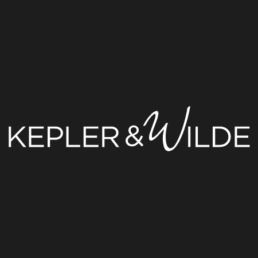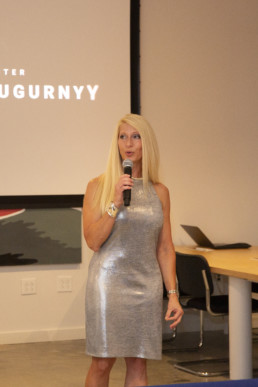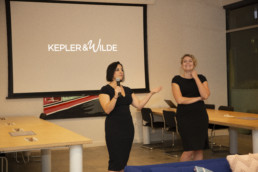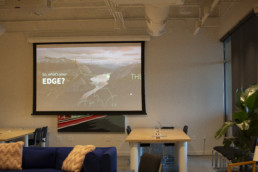Our Commitment to You During COVID-19
Our Commitment to You During COVID-19
During this uncertain time, the leadership of Kepler & Wilde wanted to personally thank you for your commitment to our agency. We are taking the COVID-19 outbreak and current state of the market seriously and are committed to helping every single one of you wade through this storm.
Given the severity of this situation and current online climate, as your marketing resource, we would like to share our commitment to you and recommend the following communication activities for the health and perception of your business:
- Our Commitment to You:
We are committed to you and the health of your business, period. We are here to help pivot your marketing activities and make sure you are making the right decisions that will in no way compromise your brand’s perception or lead generation efforts. We are here to help you avoid stagnation and keep the conversation going. During our next stand-up, we would love to discuss how we can craft your future messaging and keep you on track to emerge from this unfortunate time a stable and thoughtful brand. - Campaign Activity:
Major B2C & B2B brands are suspending all campaign activity and those that are not are starting to receive major backlash online for insensitive ads and selfishly promoting services during a time of crisis. For the next 4-6 weeks, we recommend suspending pure sales or promotional product online activity. Instead, keep people engaged with virtual events that promote a more altruistic nature and evoke a sense of community. Keep lead generation or sales activities on a virtual one-to-one basis. Communicate that you are here to keep everyone’s business healthy, not just your own. And don’t forget to work with your partners on virtual events that bring everyone together. - Virtual Meetings:
We feel it is our social responsibility to move all future Kepler & Wilde meetings online. If we have an in-person meeting scheduled with you, we will reach out to move it to a virtual location. If you prefer Go-to-meetings or Uber Conference over Teams, just let us know! We are happy to oblige to whatever format you need to be the most productive.
Lastly, thank you again for your continued support and know that no matter what we will get through this together and come out the other side stronger than ever before.
Stay safe, wash your hands, practice social distancing, and know we are here to help!
Warm regards,
Christy Harner & Tara Fusco
How to Pivot Your B2B Event Marketing Strategy and Still Hit Your Numbers
How to Pivot Your B2B Event Marketing Strategy and Still Hit Your Numbers
As events continue to cancel and the coronavirus mandates remote work, many are wondering, in a climate of uncertainty, how can we pivot our marketing efforts and still stay on track to hit our numbers. Whether you’re relying on conferences or a traveling roadshow of dinners and lunch-n-learns to hit your OKRs, there are steps you can take to mitigate the abundance of cancellations to come.
Here are a few tips to calm the nerves and include in your presentation to leadership. (Because you know, your CEO will ask, if they haven’t already, to put together a deck outlining your event contingency plan.)
Tip 1: If you are a conference sponsor, get creative and work with the conference on a virtual engagement plan.
Conferences are a critical component to creating awareness, building your contact database and, ultimately, lead generation for your sales team. If you have invested in sponsorship, you are all in and expect to see ROI. On the flip side, conferences need us right now as much as we need them. They need us to stay loyal, keep engaged, and do everything we can to help avoid attendance numbers nosediving when they can finally reschedule.
Contact your conference liaison and ask if they have are open to creating a virtual engagement alternative like a webinar, email marketing series, or social media campaign. You can still leverage the attendee list, provide quality content, and have a CTA matching your quarterly objectives. Remember, you never know until you ask!
Tip 2: Begin to reallocate funds to video and (prospective customer) contributor content.
Video is consumed 4x more than any other content. If you have the ability to reallocate funds to video content creation this is the time to do it. Depending on your current customer journey needs, it may be time to beef up that product video, create compelling customer testimonials, or conduct a series of thought leadership interviews with prospective clients.
If you have the inclination to start bombarding your leads and prospects with more phone calls or lunches, don’t. Every other company has the same inclination and your leads’ already overflowing inboxes will become saturated with salespeople. To stand out and get your emails answered, try a different approach — ask your future or current customers to contribute to your content. Put them on your podcast, interview them for a video or blog. The goal here is to keep everyone engaged and much as possible so the sales cycle doesn’t stall.
Tip 3: To all of my marketers, support sales as much as possible.
As a marketer, I know the pressure to pivot and still perform in this climate is daunting. You have to find a way to supplement mass awareness and speaking engagements with digital marketing efforts. This is why I emphasize, realign yourself with sales and understand what they need to keep going.
Look back at your campaign and content performance data and come to the table with what works and, more importantly, what doesn’t. Understand your sales team’s expected event metrics and figure out what you can produce to help move them virtually move the needle. Support may come in the form of more case studies, sales decks, smart content, more sophisticated and targeted email drip campaigns, or more engaging webinars with longer live Q&As. Whatever it is make sure your copywriters are well caffeinated, graphic designers are on call, and MarTech is up for the challenge. This is the time when marketing automation needs to thrive and start working like a well-oiled machine.
Please comment and contribute! Let us know how your company is pivoting and the steps your marketing department is taking to keep sales stable.
The Marketing Data Every Founder & Investor Needs
We've compiled 5 types of marketing data every founder and investor should have in their back pocket.
This year, Kepler & Wilde’s CEO, Christy Harner, and CMO, Tara Fusco, had the pleasure of speaking at Seed the South during Charlotte Innovation Week.
Our team presented: Demystifying Numbers, The Marketing Data Every Founder Needs to Know!
Download the exact presentation presented at the event and learn how to:
- Uncover meaningful KPIs
- Communicate quality user metrics over quanity
- Avoid numbers that will only lead to smoke screens and inaccurate projections.
Bonus: We also cover marketing budgets and customer advosiry board data!
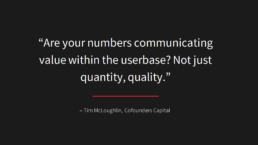
“This session covered everything! From product data to adoptability and overall marketing spend, I now know what I can bring to the table to communicate value and engage customers.” – Charlotte Start-up Fintech Founder
Ebook | 2020 The Year of the Channel Partner
You are tasked with developing a channel partnership program and execution plan, now what?
With scalable revenue and measureable ROI always top of mind, we realize you must look to partnerships to support the necessary and continuous touchpoints your customers need to engage, convert, and become champions of your brand. That is why Kepler & Wilde has officially deemed 2020 to be the year of channel partner.
This ebook will show you…
- How to Choose a Channel Partner
- How to Create a Shared Vision of Success
- Which KPIs to Consider
- How to Create the Content Your Partner Needs
- How to Develop a Customized Sales & Marketing Toolbox
DOWNLOAD THE EBOOK
“With clear objectives, team alignment, and the right toolbox, channel partnerships are a practical and profitable strategy that can lead to lower customer acquisition costs (CACs), increased lifetime value (LTV), and that elusive hockey-stick graph your investors keep itching to see.” – 2020: The Year of the Channel Partner
125 B2B Marketing Stats to Get You Started in 2020
125 B2B Marketing Stats to Get You Started in 2020
You read correctly, 125 B2B marketing, B2B content, B2B sales, and B2B digital stats. As we embark on a new decade, we have the unique opportunity to leverage years of marketing data, case studies, and real-world experiences to fuel future content creation, sales strategies, digital investments, and customer journeys for years to come.
The following statistics are great for practical implementation across your sales and marketing teams as well as guiding strategy and crafting budgets with key stakeholders.
So, sit back, sip your coffee, and enjoy 125 statistics that will empower your marketing team to hit the ground running in 2020!

B2B Marketing
- 80% of B2B buying decisions are based on a buyer's direct or indirect customer experience, and only 20% is based on the price or the actual offering. (CMO, 2019)
- 90% of B2B buyers now twist and turn through the sales funnel, looping back and repeating at least one or more task in the buyer's journey. (CMO, 2019)
- B2B industry professionals list lack of budget (59%) and the inability to reach the right people at the right time (39%) as their biggest obstacles (CMO, 2014)
- 52% of marketers say their company's ability to measure and analyze marketing impact is either sub-par or non-existent.
- Just 28% of marketers say they are "very effective" at demonstrating the value of their marketing efforts to their peers. The majority (69%) say that they are only "somewhat effective" at it. (KoMarketing, 2017)
- 96% of B2B buyers want content with more input from industry thought leaders. (Demand Gen Report, 2016)
- 73% of B2B buyers say they want a personalized, B2C-like customer experience. (Accenture, 2017)
- 71% of B2B buyers say customers increasingly want B2C-like experiences - faster response times and 24/7 availability-but nearly half (49%) say they're failing to deliver the personalized experiences their customers crave.
- 80% of U.S. marketers said they wanted to use integrated marketing and advertising technology from a single vendor. (Google, 2018)
- In the B2B setting, events help generate the most leads, while case studies help convert and accelerate the most leads. (Marketing Charts, 2018)
- 28% of marketing professionals have reallocated their traditional advertising budget to digital marketing. (Gartner, 2013)
- 50% of B2B Marketers see producing content consistently as a top content marketing challenge. (LinkedIn, 2015)
- 53% of B2B marketers have small or one-person content teams serving their entire organizations. (Content Marketing Institute, 2018)
- 69% of successful B2B marketers have a documented content marketing strategy. (Content Marketing Institute, 2019)
- The most successful content marketers have access to 40% of the total marketing budget, and the least successful have just 14% of the marketing budget. (Content Marketing Institute, 2018)
- More than half of all B2B buyers view at least eight pieces of content during the purchase process, and 82% of buyers viewed at least 5 pieces of content from the vendor prior to purchase. (Forrester)
- While over 30% of marketers think voice search is the next big trend, 60% have no strategy to incorporate it into their business strategy (EConsultancy, 2017)
- 1 in 3 B2B marketing professionals say finding new hires who are trained in content marketing is more challenging than ever (Content Marketing Institute, 2014)
- In 2015, 46 percent of B2B professionals are millennials (It’s now over 50%) (Think With Google, 2015)
- 34% of marketers are STILL not paying for their social media management tools (Advanced Web Ranking, 2017)
- 46% of all B2B researchers and buyers are millennials. (Google, 2015)
- Mobile drives or influences an average of more than 40% of revenue in leading B2B organizations. (Google, 2017)
- 50% of B2B search queries today are made on smartphones, and this percentage will grow to 70% by 2020.
- 86% of B2B marketers want to see products and services on a vendor's website home page, 52% want to see about/company information, 27% want to see testimonials, and 23% want to see marketing collateral. Details about technical support (59%) and pricing (43%) are also important to marketers. (KoMarketing, 2015)
- 69% of buyers indicated that "excessive form field requirements" would deter them from completing a contact form, with 65% stating they wouldn't submit a form if "too much personal information" was required. If the form included an automatic email subscription, 55% said that would deter them as well. (KoMarketing, 2015)
- 80% of business decision-makers favor getting brand information via an article series more than ads (Content Marketing Institute)
- 44% would like access to an ROI calculator for buying decisions.

B2B Content
- 91% percent of B2B marketers are doing content marketing. (Content Marketing Institute, 2018)
- 85% of B2B marketers say lead generation is their most important content marketing goal. (Ring Lead, 2017)
- For every $1 spent in email marketing, the average campaign earns $38 in ROI (Campaign Manager, 2016)
- Marketers see an average of 760% increase in revenue from customized, segmented email campaigns. (CampaignMonitor, 2017)
- 81% of businesses use video as a marketing tool (Experian, 2018)
- 96% of B2B companies plan to use video in their content marketing over the next year. (Social Media Today)
- 73% of B2B marketers say that video positively impacts marketing ROI.
- 70% of B2B buyers and researchers watch videos on their path to purchase.
- Infographic search volumes have increased by over 800% (Unbounce, 2012)
- 51% of B2B marketers prioritize creating visual assets as part of their content marketing strategy. (HubSpot, 2019)
- 86% of B2B companies maintain a blog (The Real-Time Report, 2010)
- 81% of businesses reported their blog as being critical to B2B lead generation. (Nurture)
- In a recent survey, over 40% of people admit they skim over blog posts (Hubspot, 2016)
- Blog posts with 6-13 word titles attract the most clicks (State of Inbound Report, 2017)
- Companies that blog 15 or more times per month drive 5x more traffic than companies that don’t blog. (Hubspot, 2016)
- 43% of B2B marketers say blogging is their most important type of content. (Social Marketing Industry Report, 2017)
- 29% of marketers repurpose existing content (Curata, 2016)
- The typical blog post is 1,050 words long. (Orbit, 2016)
- 48% of marketers are adding Youtube to their content distribution channel plan for the next year (State of Inbound Report, 2017)
- When an employee shares company content, their CTR is two times higher than if their company were to share the same content. (Ironpaper, 2017)
- 46% of B2B marketers say that professional quality photography is critical (CMO Council, 2016)
- 64% of B2B marketers hire freelancers to outsource writing projects. (Top Rank Marketing, 2014)
- The average person will only spend 37 seconds reading your article (Content Marketing Institute, 2016)
- Creative and personalized subject lines are 26% more likely to be opened than a generic phrase. (Experian, 2016)
- The leading reason business buyers have limited engagement with B2B vendors is because marketers are sending them too much irrelevant content (34%). (KoMarketing)
- 45% are looking for personalized content portals.
- 79% of B2B marketers credit email as the most effective distribution channel for demand gen efforts. (Content Marketing Institute, 2018)
- 32% say confusing content makes buying decisions more difficult.
- 90% of B2B marketers say the leading attribute of content marketing effectiveness is "audience relevance" (Statista, 2018)
- The top 2 technologies B2B organizations use to assist with content marketing are analytics tools (86%) and email marketing software (85%). (Content Marketing Institute, 2019)
- The average number of audiences B2B marketers create content for is 4. The average is higher in large companies (5) and lowers in small companies (3). (Content Marketing Institute, 2019)
- The top 3 types of content B2B marketers use are social media content (95%), blog posts/short articles (89%), and email newsletters (81%). (Content Marketing Institute, 2019)
- The five most engaging phrases to include in B2B post headlines on social media are "the future of," "X ways to," "need to know," "in the world," and "of the year." And keep them short: while the most engaging headlines for consumer posts run between 12 and 18 words, the most effective length for B2B headlines are in the five to 10-word range. (BuzzSumo)
- 76% of B2B marketers prioritize content quality over quantity. (Content Marketing Institute, 2018)
- 35% of B2B content marketers can measure ROI, 47% admit that they can't measure ROI and 18% aren't sure. (Content Marketing Institute, 2018)

B2B Sales
- The majority of senior executives (92%) own a smartphone used for business, with 77% reporting they use their smartphone to research a product or service for their business. While the majority (93%) go on to purchase that product via the Internet using a laptop or desktop, 50% of these executives have purchased IT products for business using their smartphone, with 13% reporting making a purchase between $1,000 to $4,999. (IDG Global Solutions)
- 68% of B2B companies have not identified their sales funnel. (Marketing Sherpa)
- 78% of executives say that an unsolicited email has led to a face to face meeting or event attendance at some point. (ITSMA, 2019)
- 62% of buyers say they can make a business decision based on online content alone. (2019)
- 49% of B2B marketers say articles are the most effective type of content for moving prospects through the sales funnel (Statista, 2017)
- Most B2B buyers are already 57% of the way through the buying process before the first meeting with a representative. (Accenture, 2018)
- B2B buying cycles are getting longer and more complex-58% of buyers said their decision process was longer in 2017 than in 2016; just 10% said purchase time decreased. Buyers are conducting more detailed ROI analysis before making a purchase decision (77%); using more information sources for research and evaluation (75%), and increasing the number of buying group members (52%). (Business2Community, 2017)
- 50% of LinkedIn users say they are more likely to buy from a company they interact with on LinkedIn. (Ironpaper, 2017)
- In 2017, it has been reported that 80% of B2B social media leads stem from LinkedIn (Ironpaper, 2017)
- 45% of marketers have gained customers through LinkedIn. (Quick Sprout)
- 65% of B2B companies have acquired a customer through LinkedIn paid ads. (HubSpot, 2018)
- LinkedIn is 277% more effective in generating leads than Facebook. (HubSpot, 2018)
- A new survey by Sacunas reveals 73 percent of millennials are involved in some aspect of purchasing decisions at their B2B companies; and at one-third of companies, a millennial is the sole decision-maker. (RDW Group, 2016)
- Mobile marketing can accelerate time to B2B purchases by 20%. (BCG, 2017)
- 80% of B2B executives research products or services on a tablet in the evening. (IDG Global Solutions)
- 57% of B2B marketers stated that SEO generates more leads than any other marketing initiative. (Junto, 2017)
- A personalized web experience can increase sales by 19% (MarTechAdvisor, 2018)
- B2B e-commerce sales are expected to outgrow B2C e-commerce sales by 2020. (Ecommerce Platforms, 2018)
- B2B e-commerce will exceed 12% of all B2B revenue by 2020. (BCG, 2017)
- 86% of buyers say they are "overwhelmed and annoyed" with more than 10 pieces of review content (BizReport, 2018)

B2B Digital
- 63% of marketers believe their biggest challenge is generating traffic and leads (State of Inbound Report, 2017)
- 36% of desktop users click on the first search result they see. (Advanced Web Ranking, 2015)
- 22% of smartphone owners worldwide use their device every 5 minutes (Advanced Web Ranking, 2017)
- 1 in 5 Smartphone Owners Worldwide Use Their Device Every 5 Minutes (“Always On – A Global Perspective of Consumer Mobile Experience” study, 2017)
- More than 1 in 3 people in Brazil use their mobile devices for over 6 hours a day. (Advanced Web Ranking, 2017)
- Over half (53%) of emails are opened on mobile devices. (Campaign Monitor, 2015)
- Digital channels matter most: 56 percent of millennials report search engines, vendor websites and social media are the most important sources of information when researching new products. (RDW Group, 2016)
- 58% of B2B marketers pay to advertise on search engines and believe it is the most effective paid method of digital marketing (Consalta)
- 94% of B2B marketers use LinkedIn for content distribution (Content Marketing Institute, 2015)
- 200 million people use ad-blocking technology (Content Marketing Institute, 2016)
- 76% of Facebook users visit every single day (Business2Community, 2017)
- More than 9 in 10 mothers are active on a social networking website or service (Edison Research, 2017)
- Professional SEO services are requested by almost 30% of all customers (Advanced Web Ranking, 2017)
- Even in industrial and manufacturing industries, 67% of purchases are influenced by digital (Google, 2019)
- Mobile usage per B2B worker is expected to increase from two hours a day to three by 2020, driven by millennials, Gen Z, and the increasing use of smartphones by older workers. (Google, 2017)
- 60% of B2B buyers report that mobile played a significant role in a recent purchase. (BCG, 2017)
- 80% of B2B buyers use a mobile device at work. (BCG, 2017)
- 70% of B2B buyers increased mobile usage significantly over the past two to three years, and 60% expect to continue to increase their mobile usage. (BCG, 2017)
- More than 90% of buyers say they're likely to buy again from a vendor that had a superior mobile experience, compared to 50% of those who report a poor experience. (BCG, 2017)
- 46% will leave a website because of a lack of message (it's not clear what the company does), and 37% will leave because of poor design or navigation. (MarketingProfs, 2015)
- 22% (11 out of 50) of the fastest-growing B2B companies have a live chat widget on their website. (Drift)
- 42% of companies have a mobile-optimized website (B2BMarketingZone, 2018)
- 44% of B2B marketers say the main reason they abandon websites is that there's no contact info immediately visible. (KoMarketing, 2015)
- IT, B2B, and wholesale companies have the weakest mobile email opens, while TV/radio/film, events, and real estate have the strongest mobile email opens. (Campaign Monitor, 2018)
- 59% of B2B marketers say SEO has the biggest impact on their lead generation goals. (Marketing Charts)
- Strategic landing pages are used by 68% of B2B businesses to acquire leads. (Marketo, 2018)
- 45% of enterprises are investing more than $20,000 on SEO each month. (B2BMarketingZone, 2018)
- 71% of B2B researchers begin their research with generic Google searches.
- 90% of B2B researchers who are online use search specifically to research business purchases. (Google, 2015)
- On average, B2B researchers do 12 searches prior to engaging on a specific brand's site. (Google, 2015)
- Only roughly 20% of the information on B2B websites out there displays characteristics of buyer enablement
- 84% of B2B marketers use paid distribution channels (like Instagram, LinkedIn, Facebook, YouTube, and more) for content marketing purposes. (Content Marketing Institute, 2019)
- 75% of B2B buyers use social media to support their purchase decision. (HubSpot, 2017)
- Only 47% of marketers say they are actively using LinkedIn. (HubSpot, 2018)
- Businesses on Twitter generate twice the amount of leads as opposed to those not on the platform. (HubSpot, 2018)
- Facebook (89%), LinkedIn (81%) and Twitter (75%) are the three most used social media channels by B2B marketers. Instagram is up and coming. (MarTechAdvisor)
- 33% of B2B businesses use Instagram.
- Nine out of 10 Americans worry about online privacy and data security. (Marketing Dive)
- 67% of all consumers have taken steps to defend their personal data, by limiting tracking or providing false information to companies. (Forbes)
- Brands that are upfront about how they use the information to target ads can boost engagement levels by up to 40%. (Marketing Dive)
- 75% of customers surveyed are more willing to share personal data with a brand they trust. (Forbes)
- The European Union’s General Data Protection Regulation (GDPR) is the most robust privacy protection law in the world to date. (Privacy Policies, 2019)
- In the U.S., all 50 states as well as Washington D.C., Guam, Puerto Rico, and all the U.S. Virgin Islands, have enacted laws that require businesses to notify consumers if their personal information is compromised. (Data Protection Online Report, 2019)
3 Ways to Measure B2B Brand Perception
3 Ways to Measure B2B Brand Perception
From brand awareness to customer loyalty, every experience someone has with your brand informs the larger market perception. A fellow marketer once said it best, “it’s like putting a face to a name.” Brand perception is a vital component of your overall marketing strategy and will help dictate future resource allocation as well as spend.
Brand Perception Today
Today’s B2B brands are somewhere in between AI sentiment analysis and an antiquated NPS score. For everyone else, if you’re grasping at the straws of your customer’s perception then it’s time to wake up and smell the bad reviews.
If you watched this season’s Silicon Valley, you got a witty and not so far-fetched depiction of Data Mining for Sentiment Analysis 101. If you haven’t seen it, I’m sure HBO will show you an ad after reading this blog – if not, make sure to catch up on the last few seasons… it’s a must.
However, for someone who spent the last decade in the tech sector, this show always hits a little too close to home. But IT IS a great reminder of what is well within reach for those who are obsessed with customer success teams, and knowing what to say, when to say it, and how to make someone take an action at the right time while growing loyalty and expansion within an existing base.
62% of customers say they share bad experiences with others*
For businesses that don’t have millions to spend on data science for the marketing department – yes that’s a real thing – there are few actions you can take to easily assess your customer’s perception, areas for improvement, and ways to showcase what you’re doing right!
82% of business buyers want the same experience as when they’re buying for themselves.*
Here are 3 easy steps you can take today, this week, and this month to get started:
- Google Alerts – Do it today.
- You can set up Google Alerts in less than a minute. Face it, you don’t have the time or resources for someone to monitor the internet 24/7. Google Alerts will do it for you. Just insert the keywords you want to monitor—such as your company’s name, a specific product/service you offer, or competitive terms – and anytime those keywords appear online, Google will email you an alert. It’s literally that simple.
- MarTech Stack – Do it this week.
- Let’s face it, one bad review in Google’s search results can cause you to lose 70 percent of potential customers. From directories to negative social media interactions, there is a lot to read. Here are some tools that can capture a holistic view of your brand’s perception and help you prioritize what to listen to and how to respond.
- Meltwater
- Hootsuite Insights(formerly uberVu via Hootsuite)
- Talkwalker
- Brandwatch
- Amazon’s AWS Comprehend – (for the mature marketing department)
- NuanceAnalytics for Speech Recognition
- Let’s face it, one bad review in Google’s search results can cause you to lose 70 percent of potential customers. From directories to negative social media interactions, there is a lot to read. Here are some tools that can capture a holistic view of your brand’s perception and help you prioritize what to listen to and how to respond.
- Surveys – Do it this month.
- When it comes to measuring brand perception, customer surveys are your best friend. However, the most vital component of your survey is timing. It must capture feedback at critical moments of the customer journey. Here are a few well-known surveys you can design and implement this month:
- A customer satisfaction (CSAT) survey measures customer health by asking customers targeted questions. It’s usually sent after a specific customer experience—like a purchase or customer support interaction.
- Net Promoter Score® (NPS®) measures customer loyalty with a simple question: How likely are you to recommend us? The NPS survey is typically sent at specific stages of the customer lifecycle and is a fantastic way to identify brand advocates. [For those who have Salesforce, the platform will integrate your NPS scores giving you more visibility and actionable insights.]
- A product survey measures product satisfaction and stickiness. It gives marketing and development teams unique insights on messaging, value propositions and pain points. All of which can inform your competitive positioning.
- When it comes to measuring brand perception, customer surveys are your best friend. However, the most vital component of your survey is timing. It must capture feedback at critical moments of the customer journey. Here are a few well-known surveys you can design and implement this month:
How will these tactics help your bottom line? A true understanding of these areas will allow your business to graduate from apologetic customer support reps to message refinement, testing, delivery, and conversion. More importantly, it will help you develop a product by the customer for the customer.
If you still need to convince stakeholders to invest time into analyzing your brand’s perception, not to mention something that directly affects your profitability, we, at Kepler & Wilde, would like to leave you with these reviews that popped up on Page 1 of Google when we researched software for our own company.
Real Software Reviews from TrustPilot Review Directory

*Salesforce Report, State of the Connected Consumer
Charlotte Launch Party
We know it takes a village and we thank you!
First and foremost, thank you to everyone who attended our launch party in Charlotte, NC. The love and support permeated WeWork and we could not be more grateful for the community that surrounded us Thursday evening.
Big shout outs to WeWork @TheRailYard for hosting the space, The Common Market for catering the most delicious apps, and Free Range Brewing for making sure everyone had a beer in their hand. We would also like to thank Home Grown Real Estate, Aspire Community Capital, and Bishop, Dulaney, Joyner & Abner for sponsoring the event.
As we begin this chapter, the Kepler & Wilde team will not forget where it started and the foundation our community constructed over the last decade. We would not be here without you. This will not be the last party we host but to all that attended on that warm Fall-ish evening, know, nothing will ever take the place of that time we got together and launched our company.
Our immense gratitude could take a few hundred or more words, so we will leave it at this…
Here’s to a very wilde ride, we’re glad you’re on board.
Your eternally grateful founders,
Christy & Tara
Press Release: Female Founders Launch Kepler & Wilde to Transform the Way You Approach Marketing
Female Founders Launch Kepler & Wilde to Transform the Way You Approach Marketing
Charlotte NC's newest agency brings 25 years of combined startup and corporate experience to companies ready to explore the edge of sales, marketing, and brand strategy.
Charlotte, NC (September 23, 2019) – Today, North Carolina adds another company to its women-owned venture list. Co-Founders and marketing strategists Christy Harner and Tara Fusco have partnered to launch Kepler & Wilde Charlotte’s newest marketing agency with over 25 years of combined marketing strategy and brand development experience.
Why is Kepler & Wilde different? Christy Harner, Co-Founder and CEO explains, “Kepler & Wilde is dedicated to exploring the edge of marketing. The age of the ill-informed customer is over. Brands need to establish an emotional connection while creating compelling stories and unforgettable experiences.” Harner adds, “Over the past 15 years, Tara and I have been in the startup and corporate trenches. We’ve sold companies, served global enterprises, and successfully lead campaigns that have made headlines and experienced triple-digit growth. We know success follows alignment and deliberate data-driven strategy and we are here to bring organizations closer to their customers."
Harner is a well-known marketing strategist in the Charlotte area, an NC IDEA Fellow, and the Director of Entrepreneurial Experience for Innovate Charlotte. Over the past 15 years, she has helped raise millions of dollars in capital, developed products, sold companies, built marketing strategies for over 100 Charlotte-based companies, and had startups featured in TechCrunch and Shark Tank. Harner is also completing her MBA at Queens University of Charlotte as well as serving on the board of Aspire Community Capital.
As Harner takes on the role of Chief Executive Officer, Tara Fusco will serve as the company’s Co-Founder and Chief Marketing Officer.
“According to a recent study only 1 in 4 companies have women in the C-suite, and only 6% hold CEO titles. This is abysmal,” says Tara Fusco, Co-Founder and CMO. “Kepler & Wilde will transform the agency model and how organizations approach marketing. From helping companies grow and owning lean and agile methodologies to supporting the local economy, we want to create an agency that is emblematic of transforming the status quo and improving the human experience.”
With over 10 years of corporate brand, marketing, and communications strategy and implementation experience, Tara has led growth-driven marketing teams for consulting firms, software companies, and, more recently, a multi-billion-dollar manufacturer in Raleigh-Durham, North Carolina. From her in-depth knowledge of the technology sector and digital transformation to her diverse industry experience, Tara’s campaigns have empowered companies to achieve exponential growth and headlines in Forbes and the Wall Street Journal as well as multiple awards including coveted CES recognition. Tara received her degree in Communications from Appalachian State University, is a guest lecturer on the topic of Big Data and New Media and was a fellow for NextGen Climate during the 2016 Presidential election.
Based out of WeWork in Charlotte and Durham, NC, Kepler & Wilde aims to be the model of a lean organization focused on empowering customers and community.
Kepler & Wilde is hosting a launch party this week at the new Charlotte WeWork @TheRailYard in SouthEnd. To inquire about tickets, contact tarafusco@keplerandwilde.com. To learn more about the company, check out keplerandwilde.com
